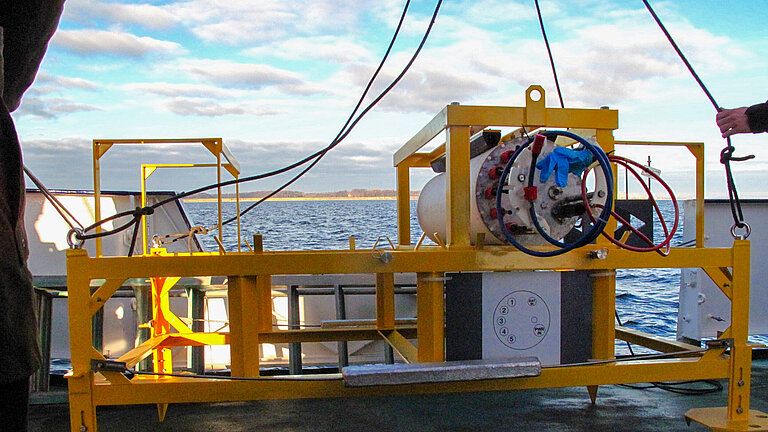Anna Niewerth
Phone: +49 (0) 431 600 2812
E-Mail: aniewerth(at)geomar.de
Data collector on the seafloor
New measuring node off Boknis Eck to be installed today
Data on the state of the Baltic Sea have been collected at Boknis Eck on a monthly basis since 1957. This makes it one of the oldest marine time series stations in the world and an important part of international marine research.
For sixty years, measurements were taken from research vessels, and even today a small crew of scientists sets out every month from Kiel on the FK LITTORINA to Boknis Eck to take water samples from various depths with the crane water sampler and then analyse them in the laboratory. For example, temperature, salinity, oxygen and carbon dioxide concentrations are measured. The data series are invaluable for research and help to identify long-term environmental changes in the ocean.
Discrete and continuous data collection
“This method is called discrete data collection,” explains Dr Helmke Hepach. She is an environmental scientist at the GEOMAR Helmholtz Centre for Ocean Research in Kiel and has been responsible for the Boknis Eck measuring station since December 2021. “The data provide a basis for analysing the complex ecological relationships.” In 2016, data collection reached a new milestone with the installation of a permanent underwater observatory at a depth of around 15 metres. This setup initially consisted of two desk-sized racks, which were complemented in January 2019 by an eight-metre-high, pyramid-shaped structure. The measuring node was equipped with advanced sensors to monitor parameters such as current speed and direction. “For the first time, the observatory enabled us to document short-term changes and dynamic processes, such as the effects of storms or the formation of oxygen minimum zones in high resolution,” explains Helmke Hepach.
Observatory disappears in 2019
On 21 August 2019, the underwater observatory suddenly stopped transmitting data. Professor Dr Hermann Bange, head of GEOMAR’s Trace Gas Biogeochemistry working group and coordinator of the Boknis Eck station, initially suspected a technical fault. However, what the divers discovered was far more alarming: the power cable had been torn off and two of the three racks had vanished without a trace. Only the eight-metre-high tower, which had been installed earlier that year, remained in place.
“We were faced with a complete mystery,” recalls Bange. Despite an extensive search effort involving the police and multiple research vessels, only one of the two missing racks was recovered in February 2020. It was found heavily damaged about 200 metres north-north-east of its original location. The fate of the second rack remains unknown. “It was a bitter loss,” says Bange. “Not only was the equipment gone, but we also lost valuable data critical to our time series research.”
2024: A New Measuring Node for Boknis Eck
Following the loss of the original observatory, a replacement system was developed: a pre-used underwater observatory from Helgoland was adapted to meet the specific requirements of Boknis Eck, equipped with state-of-the-art sensors, and thoroughly tested. A new submarine cable has also been laid. Today, the new measuring node was brought to its position by the FS ALKOR, lowered to the seafloor and connected with the help of research divers from the University of Kiel.
“With this, we can finally resume collecting continuous measurement data,” says Helmke Hepach. “These data are essential to get a more complete picture of the dynamic processes in the Baltic Sea”. The data collected is used not only for GEOMAR’s own research, but also in international networks such as the Coastal Observing System for Northern and Arctic Seas (COSYNA) or the CREATE project, which tests the suitability of sensor data for administrative environmental status assessments. They document long-term environmental changes in the Baltic Sea and make an important contribution to international marine and climate research.
“We hope that this time the observatory will be able to operate undisturbed for many years,” says Professor Bange.
![[Translate to English:] A yellow metal frame stands on board a research vesselprivate](/fileadmin/_processed_/0/4/csm_2024-11-20_Boknis-Eck_Messknoten_c_sarah-Uphoff-0056_25bb315249.jpg)
The new measuring node on board ALKOR: A second-hand underwater observatory from Helgoland was converted for the special requirements of Boknis Eck, equipped with state-of-the-art sensors and extensively tested. Photo: Sarah Uphoff
![[Translate to English:] A metal frame is under water, a diver swims next to itprivate](/fileadmin/_processed_/e/9/csm_2024-11-21_BoknisEck_c_JanDuda_ae490e0ee8.jpg)
The new underwater observatory was anchored to the seabed with the help of research divers from the Kiel University. Photo: Jan Duda, GEOMAR
![[Translate to English:] A research vessel at sea, the sky and water are grey](/fileadmin/_processed_/2/e/csm_2024-11-21_BoknisEck_c_DanielBrueggemann_34f3a8b30a.jpg)
The research vessel ALKOR was used to bring the measuring node to its position. Photo: Daniel Brüggemann, GEOMAR

The first underwater observatory at Boknis Eck was installed in 2016. The continuous measurements made it possible to observe dynamic processes and short-term changes in the Baltic Sea. Photo: Kiel University Research Diving Centre

In August 2019, two of the observatory's three components disappeared, and divers discovered a torn shore connection cable. Photo: Kiel University Research Diving Centre

In February 2020, the crew of the survey, wreck search and research vessel DENEB of the Bundesamt für Seeschifffahrt und Hydrographie (BSH) recovered one of the two missing racks of the Boknis Eck observatory. Photo: Martin Steen, GEOMAR


